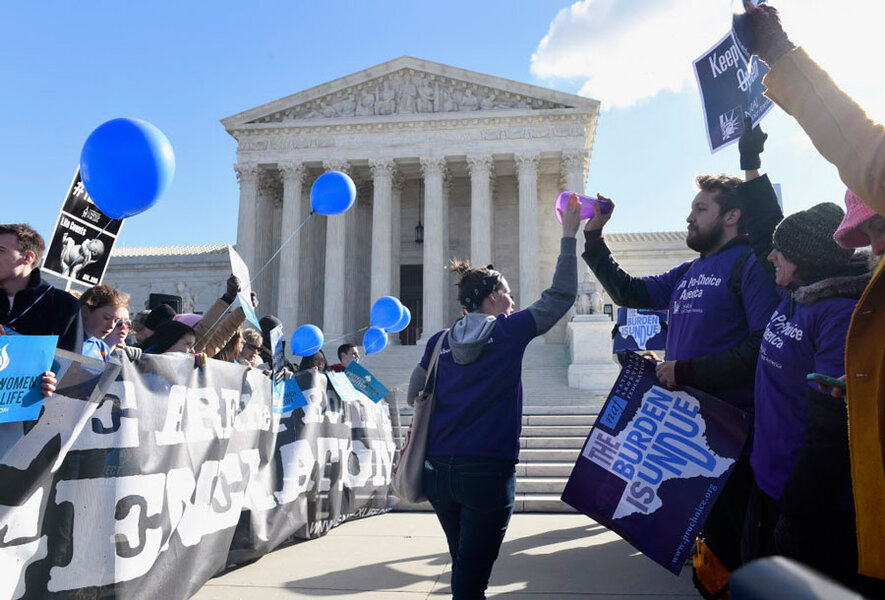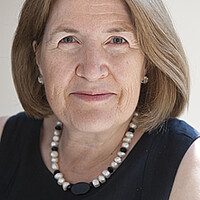In watershed abortion case, view from the Supreme Court stairs
Loading...
| Washington
In advance of Wednesday's Supreme Court hearing, the Monitor examined abortion in Texas in a three-part series looking at those most affected by the Texas law, the 'pro-life' answer to abortion clinics, and how hard it is to get an abortion in the state.
As the US Supreme Court heard oral argument for its most significant abortion case in decades, hundreds of activists and advocates rallied outside the high court in a high drama of their own, also rich with precedent.
Many wore purple shirts or carried backpacks with the logo of NARAL Now, a leading abortion-rights organization. Some 40 students and activists waited in line throughout the night in a drenching rain, in hopes of getting a seat in the high court chamber.
Sarah Smith was attending her first abortion-rights rally, holding a homemade sign reading, “Making abortion illegal doesn’t stop abortions, it stops safe abortions.”
Ms. Smith is with Jhpiego, an affiliate of Johns Hopkins University, that does international work in women's health. At a previous job with Planned Parenthood of Maryland, she worked with young women in urban Baltimore and says she values how abortion services helped them stay in school.
She has had little contact with activists on the other side of the issue, but says that there is a possibility of finding some common legal ground.
“There is a moral divide and we’ll never see eye to eye, but from a legal stance we cannot roll back the rights that have already been given to us under Roe v. Wade, regardless of religious stance,” she says.
Over the years, the balance of forces in such demonstrations has shifted. Antiabortion groups once known for turning out throngs of protesters for such a moment were down to a few scores of activists Wednesday.
Off to one side of a vast crowd of abortion-rights activists, they were falling short in the battle of the bullhorn, head count, and sign count.
“This out here is just a shouting match,” says Bonnie Borel, a retiree from Silver Spring, Md., who carries a sign claiming to show a young woman killed as a result of a legal abortion.
“It doesn’t prove anything,” she adds. “The real number of people back home is never reported by the press.”
At issue in Whole Woman’s Health v. Hellerstedt is whether a Texas law, House Bill 2, places an undue burden on women by reducing access to abortion. It places new requirements on doctors and abortion clinics, which supporters of the law say are for women's safety. These include requiring doctors to have admitting privileges at a hospital near where they perform abortions and requiring clinics to meet the safety standards of an ambulatory surgical clinic.
Since the law's passage in 2013, the number of clinics in the state has gone from 42 to 19. If the Supreme Court upholds the regulation, the number will be reduced to 10.
Twenty-five states have added one or both of the regulations to be litigated in this case.
“When we’re talking about activists, it’s hard to persuade them that the cause that they are committed to has any ambiguity, but I think a large number of Americans believe it does,” says Teresa Collett, a professor at the University of Thomas School of Law in Minneapolis, who filed a friend-of-the-court brief in support of the Texas law.
Indeed, polls show that a majority of Americans have a more nuanced view of abortions than “always” or “never.” A 2015 Gallup poll found that 51 percent of Americans believed that abortions should be legal, but only under certain circumstances. Twenty-nine percent of those polled believed it should always be legal, and 19 percent believed it should always be illegal. Those percentages have held remarkably steady over the past 40 years.
Solange Bumbaugh, an adjunct religion professor at American University in Washington, has been showing up for demonstrations in favor of abortion rights outside the Supreme Court for almost that entire time.
“In those days, I often found myself the only black woman in the crowd,” she says of demonstrations in the early 1980s. “I’m so happy to see a lot more diversity in that crowd.”
What the two groups don’t do, at least at a public forum like Wednesday’s protest, is talk to each other.
“I think that there’s a fundamental divide and I don’t think we’ll ever see eye to eye entirely, but I’m OK with that because I understand that they feel very strongly about where they stand,” says Smith.
Please see the Monitor's three-part series:
Part 1: In Texas, a side of abortion debate few ever see
Part 2: Inside the 'pro-life' answer to abortion clinics
Part 3: How difficult is it to get an abortion in Texas?
[Correction: This story has been updated to correct the name of Sarah Smith's employer, Jhpiego.]








